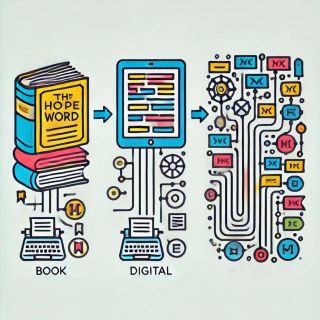Artificial Intelligence
Is the Written Word Dead in the Age of AI?
LLMs are ushering in an age of dynamic, living documents.
Posted June 28, 2024 Reviewed by Davia Sills
Key points
- Traditional text is static, while LLMs make it dynamic and interconnected, enriching understanding.
- LLMs adapt and provide interactive, personalized insights, transforming passive reading.
- LLMs amplify the text's context, offering millions of times more knowledge than human readers.

It's been said that print is dead, and the digital format has rendered ink on the page yesterday's modality for the dissemination of information. And while that's not completely the case—published books are thriving—it still reflects the technological evolution of how we consume information. In a similar way, the very nature of the written word is undergoing a transition from the static and limited presentation of words to a much richer dynamic in which these words "live" in a broader and more dynamic context, unlocking and integrating them into a vast perspective of interconnected wisdom. Let's take a closer look.
The Evolution of the Written Word
The written word has long been a cornerstone of human civilization, shaping education, culture, and communication. From ancient manuscripts to printed books, essays, and speeches, traditional text has served as the primary medium for conveying ideas. Today, we are turning the page on simple text, and large language models (LLMs) are transforming how we interact with the text. This transformation raises a provocative question: Is the traditional written word dead, and are LLMs ushering in a new age of dynamic, living documents?
The Static Nature of Traditional Text
Traditional written text, whether an essay, a book, or the 272 words of the Gettysburg Address, is inherently static. Once written, it remains unchanged, bound by the linear structure and context provided by its author. The interpretation of such text relies heavily on the reader's cognitive abilities, prior knowledge, and available resources. While this form of text has served humanity well, it has limitations in its ability to adapt and evolve in response to different contexts and inquiries.
Dynamic Connectivity: The LLM Advantage
When text is embedded in an LLM, it becomes part of a vast, interconnected web of knowledge. Each word, phrase, and concept is linked to countless other data points within the model, creating a rich tapestry of associations. This dynamic connectivity allows for a more profound and nuanced understanding of the text. For instance, when the Gettysburg Address is processed by an LLM, the model draws on its extensive training data to contextualize the speech within a broader historical, cultural, and linguistic framework.
Adaptive Context: Beyond Static Interpretation
One of the most significant and interesting advantages of LLMs is their ability to adapt to the context of text based on user interactions. A traditional reading of the Gettysburg Address is bound by the reader's cognition and the limited resources at their disposal. In contrast, an LLM can offer different interpretations and insights based on the specific queries and interests of the user. This adaptability turns static text into a living document that evolves with each interaction, providing new perspectives and deeper understanding.
Interactive Engagement: A New Dimension of Reading
LLMs transform the passive act of reading into an interactive, engaging process. Users can query the model, request elaborations, and explore related topics, making the text a responsive entity. This capability allows for a richer and more personalized reading experience. For example, a student studying the Gettysburg Address can ask the LLM for explanations of specific phrases, historical context, or comparisons to other significant speeches, thereby gaining a more comprehensive and interactive understanding.
Augmented Understanding: Enriching the Original Text
Another transformative aspect is LLMs' capacity to enrich the text with additional layers of information. When processed by an LLM, the Gettysburg Address is not just a standalone speech; it becomes a node within a broader network of historical and rhetorical knowledge. The LLM can provide background information on the Civil War, analyze rhetorical devices used by Lincoln, and draw connections to other pivotal moments in history. This augmentation offers a depth of understanding that goes beyond what static text alone can provide.
Emergent Properties: Discovering New Insights
Text within an LLM exhibits emergent properties—new insights and interpretations that arise from the complex interactions within the model. These properties can reveal patterns and connections that might not be immediately apparent in the static form. For example, the LLM might highlight themes of liberty and equality in the Gettysburg Address and relate them to contemporary discussions on civil rights and social issues. This ability to generate novel interpretations makes the text more resonant and relevant to modern readers.
Quantifying the Difference: A Vast Scale of Understanding
To appreciate the scale of difference between human cognition and LLM capabilities, consider the following quantification. A well-educated human reader might have read a few hundred books and have access to a limited number of external resources. In contrast, an LLM like GPT-4 is trained on datasets containing billions of words, equivalent to millions of books worth of information. This training allows the LLM to draw from an extensive and diverse pool of knowledge, making its capacity to contextualize and understand text orders of magnitude greater—potentially millions of times more robust than a human reader.
Embracing the Future of Text
While the written word in its traditional form remains valuable and relevant, the integration of text within LLMs represents a significant evolution. This new form of text is dynamic, interactive, and enriched, offering a more comprehensive and engaging reading experience. This shift is not about discarding the past but embracing the future, where the text becomes a living, evolving entity that provides deeper connections and insights. This partnership between human cognition and LLMs opens up a world of possibilities, enriching our engagement with the written word and elevating it to new heights—unlocking a profound and exciting journey that promises to reshape our intellectual landscape.




